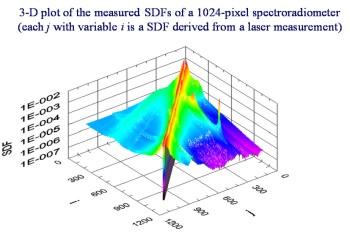Summary
Spectroradiometers are widely used for acquiring colorimetric, photometric, and radiometric quantities with a single measurement for a variety of applications in LEDs and solid-state lighting (SSL) metrology, UV radiometry, biomedical imaging, Earth remote sensing, and astronomy. This project focuses on investigating measurement issues in spectroradiometry and imaging metrology, particularly stray-light correction for array spectroradiometers and array imaging photometers/radiometers.
Description

Stray light correction
Array instruments are subject to measurement errors arising from detector's blooming, smearing, nonlinearity, and instrument's stray light. These errors (except the stray-light error) can either be avoided or corrected in many cases. However, the stray light, due to scattered or improperly imaged optical radiation within an array-type instrument, is difficult to be properly characterized and is often the dominant residual source of measurement error.
Stray light can originate from the spectral components of a "point" source and from spatial elements of an extended source. Stray light originating from the spectral components is called spectral stray light. Stray light originating from the spatial elements of an extended source is called spatial stray light.
We have developed simple matrix methods for correcting spectral and spatial stray-light errors in spectroradiometers and imaging instruments. The correction methods are based on the characterization of the instrument for a set of spectral line spread functions (SLSF) or a set of point spread functions (PSF), which are used to derive the correction matrix. The correction methods reduced stray-light errors by more than an order of magnitude, and applying these methods can result in significant reductions in the overall measurement uncertainties in radiometry, colorimetry, photometry, and many other applications.
For more information about the methods, see Stray light correction.
Spectral measurement
An array spectroradiometer is required for a gonio-spectroradiometer (spectroradiometric measurement with a goniometer), where the measurement time at each angle must be small to minimize the total measurement time over the 4π solid angle. For measurement of dim light sources such as a star, array spectroradiometers are also required where long integrating time is needed. Array spectroradiometers are widely used for measurement of light-emitting diodes (LEDs) for total luminous flux, total radiant flux, and color quantities with a single measurement and without the need to correct the large spectral mismatch errors associated with photometers, radiometers, and colorimeters.
For more details about the applications described above, see Spectral measurement.

